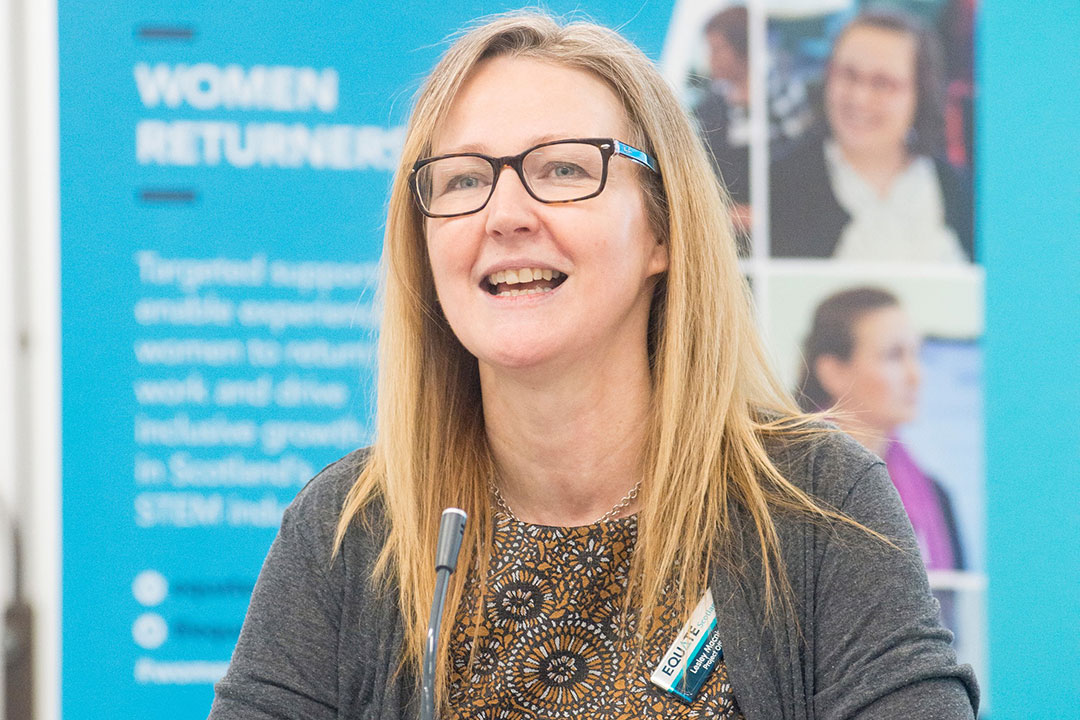Long COVID and the workplace: What employers could do better
Globally, an estimated 200 million people are living with ongoing COVID-19 symptoms, many of them in the prime of their working careers. So, what can businesses do to support them and help themselves? UK human resources professional Lesley Macniven has some ideas.
- 16 June 2022
- 8 min read
- by Linda Geddes

How did you become involved in supporting people with long COVID?
I got COVID in March 2020. When I came out the other side of it, after ten days I was still fatigued. I decided not to take on any paid work for a while, to let my body recover. I was asked to get involved with a group of people having ongoing symptoms to try to work out what was going on. That group became Long COVID Support, which is now the UK’s largest Long COVID support and patient-led advocacy organisation and a registered charity (www.longcovid.org).
We don't want people to feel sorry for us; we want our employers and colleagues to recognise that the limits placed on us by concentrating on what we can't do limits innovation.
With little guidance available in relation to Long COVID, patients like us had to call for essential research to inform change in how we live, care and work. Several Long COVID Support founding members like myself have gone on to create specialised offshoots still linked to the main group.
One of those organisations is Long COVID Work. Tell us about it.
The need for action in employment became evident during 2020. A group of people experiencing issues came together to form an employment group to help ourselves and our community.
With various professions represented, we started using our networks to reach out. I took on the role of Employment Advocacy Group Chair and began working with my professional body, the UK’s Chartered Institute of Personnel and Development (CIPD) to explore some of the issues being raised by this condition, and to work together to propose some solutions. We have now also partnered with the Society of Occupational Medicine, The Trades Union Congress (a federation of trade unions in England and Wales) and others to co-create guidance and offer specialist training informed by lived experience.
We created a LongCovidWork.co.uk website and @longcovidwork Twitter account to communicate with others grappling with this issue as workers, employers, HR or other occupational health professionals. We believe a multi-disciplinary approach is essential to help retain and support people affected by COVID-19 and Long COVID to return to work, and use our unique position to join the dots to provide clear, cohesive solutions where there is currently much confusion.
What sorts of issues are employees with Long COVID facing?
There are a couple of common scenarios. In the UK, most employment policies provide for a four-week phased return to work after a period of sick leave, to give people time to build back up to where they were before they got ill. But what we’re finding is that many people, ill for many, many months with Long COVID without any official guidance and support, need to go at a slower pace than that. Some of them are just being told ‘no’, and taken down the route towards dismissal. Or they might have a line manager who wants to support them, but the HR department is telling them to follow the standard policy. In the worst-case scenario, they’ve got a line manager who thinks they’re trying to take advantage of the situation, or that their symptoms are all in their heads.
The guidance we produce is designed to ensure an organisation takes a strategic, planned approach to managing this workforce health issue, rather than leave it to individual line managers to decide how to tackle each case.
A better situation is where there is an outline approach that allows individuals to consider how they think things will go, and then their employer works with that. We have become the experts at managing our own condition to avoid a boom and bust cycle of doing too much and being severely set back. No one has a crystal ball; pace is dictated by progress when you start back at work. You have to be prepared to be flexible.
That sounds frustrating.
We don't want people to feel sorry for us; we want our employers and colleagues to recognise that the limits placed on us by concentrating on what we can’t do limits innovation. We need to focus on what we can still contribute. Through this advocacy work we have shown that with Long COVID we are still committed, engaged in maintaining careers and financial independence. We have valuable insights into how we can make work more inclusive for the estimated 3.1% of the UK population living with Long COVID and many more who require flexibility at a time when we are at risk of slipping back into previous ways of working that denied access to talent unable to commute and work in an office for five long days a week.
Employers can also invest in their workers’ recovery. For example, look at their occupational health cover, see if they could send people for private medical tests to identify treatable aspects of their condition, such as taking beta-blockers for tachycardia (fast heart rate). Or get occupational therapists involved in helping people to redesign how they do their jobs.
When I hear politicians saying we can’t work from home, I reflect on how I’ve been working really closely with dozens and dozens of people who I have never met in real life. And we’ve achieved a lot with external partners we have never met. The important factor is a shared goal and purpose.
Have you read?
You recently produced a guidance document with the CIPD on how to support employees with ongoing symptoms. What did it recommend?
The report was to showcase good practice; things like flexibility, elongated returns to work, being driven by the worker and allowing them to pause if they have a setback – particularly, because this condition is often relapsing and remitting, and pacing can be really hard if you’re someone who likes getting things done. We don’t want to be penalising people any further for doing their absolute best. And actually, it’s counterproductive to push them too quickly.
There is a lot of excellent advice and information available online through the CIPD Long COVID Hub and on our LongCovidWork.co.uk website. We consult with organisations to help them apply that good practice. It starts with considering each case. If you have a key worker currently unable to work, but it would realistically take you six months to hire a replacement, planning accommodations that start with a very gradual return, and allowing them six months to work up to as far as they can manage, could be a better strategy.
Looking across teams and adjusting workloads and hiring to fill any gaps, perhaps at a lower level or from a larger pool of talent, we are used to recruiting to a perfect job spec. But in a tight market it can be hard to find someone who slots neatly into it. I think we need to get better at designing jobs that fit our teams’ core strengths.
Employers can also invest in their workers’ recovery. For example, look at their occupational health cover, see if they could send people for private medical tests to identify treatable aspects of their condition, such as taking beta-blockers for tachycardia (fast heart rate). Or get occupational therapists involved in helping people to redesign how they do their jobs.
Why should employers care about this issue?
The majority of people getting this condition are aged between 30 and 59 – prime working age. Many of these people are established in their careers, doing important work, and finding themselves in a situation that’s completely at odds with what they thought they’d be doing. We can’t afford to wholesale lose over 3% of our working population – particularly in sectors such as healthcare and education, which have been disproportionately affected by Long COVID.
Simply employing someone else may not be an option. Hiring highly skilled workers takes time and requires a lot of resources to do properly, ethically and fairly. Also, in some sectors employers are having to pay above market rates to attract talent due to skills shortages. There is no easy, cost-free option.
You also do not want to be the employer whose name becomes infamous in the case law that established that an employee with Long COVID you dismissed had faced disability discrimination, for which there is no ceiling on potential awards to successful employment tribunal applicants.
How are your own COVID-19 symptoms now?
I pace fairly well to make best use of my limited energy. I’m a gregarious extrovert who loves going out and socialising, but I now rarely leave the house and have done very little socialising these last two years. As advocates we focus our energy on campaigning and our families; what is most important.
Pacing has become a way of life for all of us with Long COVID. We could flee a burning building if we needed to; several days in bed afterwards would be a price worth paying to survive. But that payback, where you exceed your limits, is not sustainable day to day. The impact tends to be disproportionate to the short-term gain.
So we adopt the steady ‘tortoise’ approach rather than the impetuous hare, work in teams in a way that gets the best out of us and are passionate about helping organisations understand how to slightly shift their own culture to retain and get the best out of all their talent.
Lesley Macniven is a human resources consultant, founding member of Long COVID Support and a founder of LongCovidWork.co.uk, which supports people with Long COVID to stay in, return to, or leave work well.








